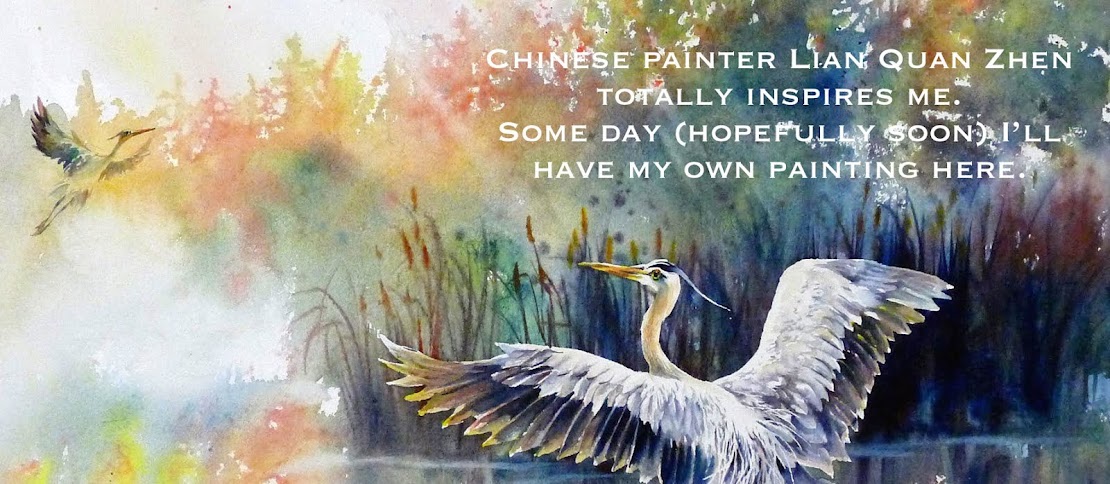There's really not much online info about either the Louvre or Mungyo Oil Pastels, but I've gotten interested in the oil pastels since the month of "Inktober" when I had met an American who was greedily purchasing the open stock Sennelier brand at Hangaram, my favorite art store here in Seoul. We started talking and she was telling me about what she planned to do with the oils and was thinking that watercolor cold-press might be a good match to lay down the color on. Hmm, I'd seen lots of oil pastels before and even purchased many sets for kids, but I'd never taken them as a serious artist medium. After talking with her though, they started to intrigue me so a couple weeks later I decided to purchase a set. Certainly not Sennelier oil pastels since they are W2,800 per stick, but a set that seemed inexpensive mid-range -- the Louvre 48-color oil pastels for W23,000.
As soon as I got home, I tried them out. Nope, not an alluring art form for me. No love. Just like coloring with crayolas. I knew they wouldn't be creamy-smooth like the Senneliers, but I didn't expect waxy crayon consistency (just slightly better really) and the need to apply firm pressure to get the colors to adhere to a sturdy rough sketchbook paper. My impression -- crayons at a glorified price.
I went online and tried to read about them, but couldn't find much. The wrappers on the pastels give a French website but clearly state they are manufactured in China. With no info on the box, I should have been clued in that they wouldn't be super good. My bad. Anyway, while looking at oil pastels online, a couple artists who didn't want the expense of the Senneliers had commented on the creaminess of the Mungyos. I just filed that info away, but with no desire to test it out.
So today, I wanted to pick up a 24-color or even 36-color Mungyo Watercolor Crayons set as the 12-color set had been such a success with my neiceling and nephew a few days ago. And what do you know, right beside the set of 24 watercolor crayons (W7,200 or about $7) was a 24-color set of Mungyo Aquarelle Oil Pastels for W6,300. For that price, why not? I could try something out, and then if I didn't like them, my neiceling and nephew and I could spend a winter afternoon just having fun with them and they would be well worth the money.
I have to say though, the Mungyos are a pleasure to use. Really fun in fact. The are quite creamy (not like the Senneliers but still nice) and just touching them to the paper leaves an oily trail of color. Like the Louvres, they do leave crayon-line waxy flakes, but those waxy flakes can be easily pushed into the paper or wiped in a color-trail across the paper with the finger. The Louvres don't manipulate much. That said, it means the Mungyos smear more easily, which I realized after my little cactus drawing was nearly done. In the future, I'll just use a piece of wax paper to buffer my hand and protect my drawing.
Here's a comparison using the greens and yellows of the Louvre 48-color set and the Mungyo 24-color set. Despite using more Louvre colors, Mungyo achieved the same richness with fewer. They were easier to lay down and blend (the yellow petals). In my opinion, the only way the Louvre had the edge on Mungyo is the pastels would be much easier for doing finer drawing as they are much harder and can hold an edge necessary for more detailed work.
 |
| Comparing Louvre Oil Pastels on the left & Mungyo Aquarelle Oil Pastels on the right |
 |
(left) Louvre oil pastels used - 1 dark blue, 5 greens, 4 yellows, 1 orange
(right) Mungyo aquarelle oil pastels used - 1 dark blue, 3 greens, 2 yellows, 1 orange
The Mungyos were much easier to lay down color, and I did intentionally smudge the yellow petals a bit on the Mungyos, a technique that didn't work so well with the Louvre pastels. |
 |
After comparing their colors, thought I'd test out the aquarelle aspect of the Mungyos. Just lightly flicked the base of the cactus barrels with a firm damp brush and the colors, even on the first stroke, flicked up the barrels. I flicked a brush 3-4 times on the largest barrel (at the base) and realized the brush was picking up the color and the contrast was disappearing. Must remember this! The Mungyos both smear easily across the paper (I think a positive point) and respond quickly to even the lightest touches of water.
For me, this means I have found an art medium for laying down quick medium and making quick adjustments to spread that color with minimal effort. Yep. Definitely like the Mungyos! |
 |
| Made this the day I bought the Louvre oil pastels. Laid down the oil color quite thickly but the sketchbook paper could still be seen through. (Same paper as the cacti above.) Then, as I saw online, dipped a wide firm brush in coconut oil and used the oil as a medium for adjusting the colors. Discovered the colors responded quite differently. The red, orange and pink blended adequately with the coconut oil, and I really worked at blending the blue of the "M" (meh, am not a keener), but the light purple pretty much refused to blend -- very waxy and crayon-like. Then, to test how much color I was picking up and moving, started swiping the page with the "loaded" brush. It's obvious the brush wasn't loaded and the colors didn't shift much ... They are just glorified crayons after all. |










































